
The Curculionidae are a family of weevils, commonly called snout beetles or true weevils. They are one of the largest animal families with 6,800 genera and 83,000 species described worldwide. They are the sister group to the family Brentidae.

Weevils are beetles belonging to the superfamily Curculionoidea, known for their elongated snouts. They are usually small – less than 6 mm in length – and herbivorous. Approximately 97,000 species of weevils are known. They belong to several families, with most of them in the family Curculionidae. It also includes bark beetles, which while morphologically dissimilar to other weevils in lacking the distinctive snout, is a subfamily of Curculionidae. Some other beetles, although not closely related, bear the name "weevil", such as the biscuit weevil, which belongs to the family Ptinidae.
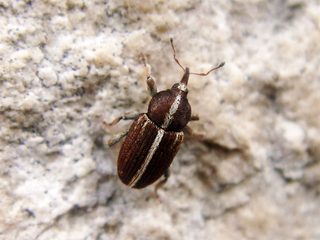
The beetle subfamily Curculioninae is part of the weevil family Curculionidae. It contains over 23,500 described species in 2,200 genera, and is therefore the largest weevil subfamily. Given that the beetle order (Coleoptera) contains about one-quarter of all known organisms, the Curculioninae represent one of the – if not the – most successful radiations of terrestrial Metazoa.

Belidae is a family of weevils, called belids or primitive weevils because they have straight antennae, unlike the "true weevils" or Curculionidae which have geniculate (elbowed) antennae. They are sometimes known as "cycad weevils", but this properly refers to a few species from the genera Parallocorynus and Rhopalotria.
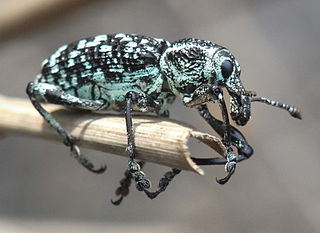
Chrysolopus spectabilis is a species of weevil found in south-eastern Australia. It was discovered during James Cook's first voyage, and became one of the first insects to be described from Australia. The weevil measures up to 25 mm (1.0 in) long and includes distinctive metallic green and black scales. It is found only on 28 species of the plant genus Acacia.
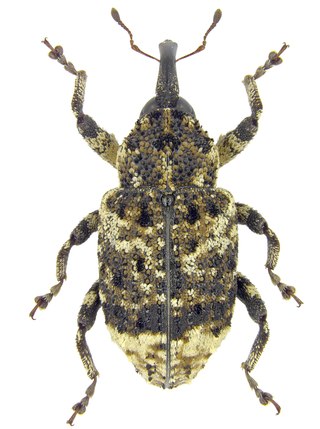
Cryptorhynchinae is a large subfamily of weevils (Curculionidae), with some 6000 species. They are found in most zoogeographic regions although they are most diverse in the Neotropics, Australia and Oceania.
Elwood Curtin Zimmerman was an American entomologist best known for his two multivolume series: Insects of Hawaii published by the University of Hawaiʻi Press and Australian Weevils published by Australia's CSIRO.

Phyllobius glaucus is a species of weevil found across Europe, especially in carrs. It is a pest of a variety of fruit trees, but has little economic effect. It was first described by Giovanni Antonio Scopoli in 1763.
Gonipterus scutellatus is a species of weevil in the family Curculionidae. It is commonly known as the eucalyptus snout beetle, the eucalyptus weevil or the gum tree weevil. It feeds and breeds on Eucalyptus trees and is endemic to Australia.

Trigonopterus is a genus of flightless weevils placed in the Cryptorhynchinae of Curculionidae. It is distributed in Australia, Indonesia and Melanesia. About 90 species had been formally described until March 2013, when a single paper more than doubled this number, agreeing with previous studies and a systematic barcoding study that many more species have yet to be described. As of October 2021, there were 480 described species.

Sternochetus mangiferae is a weevil commonly known as the mango seed weevil, mango stone weevil, or mango weevil. It is a compact weevil typical of the Cryptorhynchinae. It was first described in 1775 in the genus Curculio. The adults are 7.5-9.5 mm long and 4 mm in width.

Amycterini is a tribe of beetles in the subfamily Cyclominae.
Acamptus is a genus of true weevils in the beetle family Curculionidae. There are about nine described species in Acamptus.
Cercopeus is a genus of broad-nosed weevils in the beetle family Curculionidae. There are about 17 described species in Cercopeus.
Acantholophus is a genus of beetles belonging to the family Curculionidae.
Eduard Voss was a German entomologist, who specialized in beetles (Coleoptera), in particular the weevil family (Curculionidae). He described many new species and a number of beetles are named after him. Much of his beetle collection was lost in World War II, but some of the remaining collection is held in the Zoologischs Museum Hamburg.
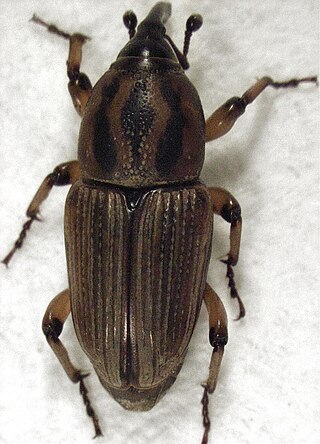
Sphenophorus brunnipennis is a beetle in the Dryophthoridae family.
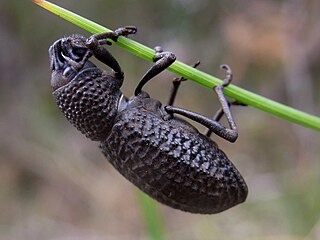
Talaurinus is a genus of weevils belonging to the family Curculionidae. The species of this genus are found in Australia. The genus first appeared in scientific literature in the Transactions of the Entomological Society of New South Wales, published by William MacLeay in 1865.

Gagatophorus is a genus of weevils belonging to the family Curculionidae, first described by Henri Jekel in 1865. The decisions for synonymy are based on work by Sigmund Schenkling and G.A.K. Marshall (Pseudamycterus), and Elwood Zimmerman.
Amycterus is a genus of weevils belonging to the Amycterini tribe in the family Curculionidae, first described by Carl Johan Schönherr in 1823. The decisions for synonymy are based on work by Alonso-Zarazaga, M.A. and Lyal, C.H.C. and Elwood Zimmerman.












